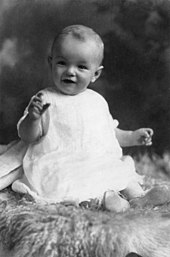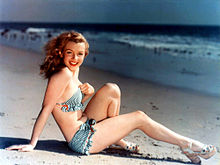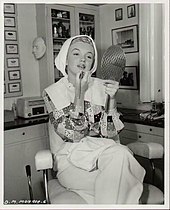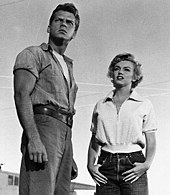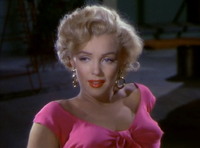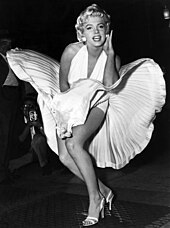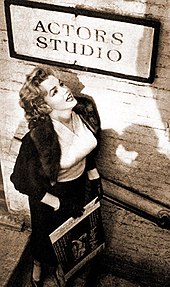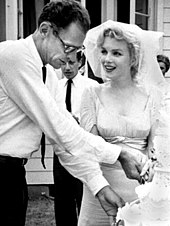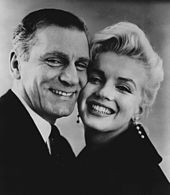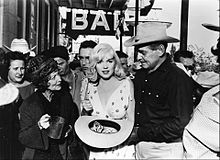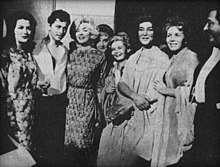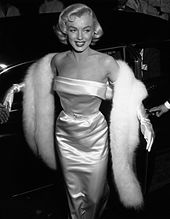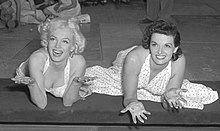Marilyn monroe
Marilyn Monroe ( /ˈmærəlɪn_mʌnˈroʊ/; born Norma Jeane Mortenson; Los Angeles, June 1, 1926-Los Angeles, August 4, 1962) was an American actress, singer, and model. Famous for playing comic "blond bombshell" personas, she became one of the most popular sex symbols of the 1950s and early 1960s, as well as an emblem of the sexual revolution of the time. the most sought-after actresses for a decade, and her films grossed $200 million (equivalent to $2 billion in 2021) at the time of her death in 1962. Long after her passing, Monroe remains a major pop culture icon In 1999, the American Film Institute ranked her sixth on its list of the greatest female film legends of Hollywood's Golden Age. Various film critics and media outlets have cited Monroe as one of the best actors who never received an Oscar nomination.
Born and raised in Los Angeles, Monroe spent most of her childhood in a total of 12 foster homes and an orphanage, marrying at the age of sixteen. She was working in a factory during World War II when she met a photographer from the First Motion Picture Unit and she began a successful career as a pin-up model, which led to short-lived film contracts with 20th Century Fox and Columbia Pictures. After a series of minor movie roles, she signed a new contract with Fox in the late 1950s. Over the next two years, she became a popular actress with roles in various comedies, including As Young as You Feel and Monkey Business, and in the dramas Clash by Night and Don't Bother to Knock. She faced a scandal when it was revealed that she had posed nude in a photo shoot before she became a star, but the story did not harm her career and instead sparked increased interest in her films.
By 1953, Monroe was one of Hollywood's most marketable stars; she had leading roles in the film noir Niagara, which overtly focused on her sex appeal, and the comedies Gentlemen Prefer Blondes and How to Marry a Millionaire, which established her star image as a "dumb blonde." The same year, photos of her posing nude of her were used as the cover of the first issue of Playboy . She played an important role in creating and managing her public image throughout her career, but she was disappointed when she was typecast and underpaid by the studio. She was briefly suspended in early 1954 for turning down a film project, but she returned to star in The Seven Year Itch (1955), one of the biggest box office successes of her career.
When the studio was still reluctant to change Monroe's contract, she founded her own film production company in 1954. She spent 1955 building the company and began studying method acting with Lee Strasberg at the Actors Studio. Later that year, he was awarded a new contract by Fox, which gave him more control and a higher salary. Later roles for her included a critically acclaimed performance in Bus Stop (1956) and her first independent production in The Prince and the Showgirl (1957). She won a Golden Globe for Best Actress for her role in Some Like It Hot (1959), a critical and commercial success. The last completed film of hers was the drama The Misfits (1961).
Monroe's troubled private life received a lot of attention. She battled addiction and mood disorders. Her marriages to retired baseball star Joe DiMaggio and playwright Arthur Miller were highly publicized but ended in divorce. On August 4, 1962, she died at age 36 of an overdose of barbiturates at her Los Angeles home. Her death was ruled a probable suicide.
Biography and career
1926-1943: childhood and first marriage
Monroe was born Norma Jeane Mortenson on June 1, 1926, at Los Angeles County Hospital in Los Angeles, California. Her mother, Gladys Pearl Baker—née Monroe—was born in Piedras Negras, Coahuila, Mexico, in a poor family from the Midwest who had immigrated to California at the turn of the century. At the age of 15, Gladys married John Newton Baker, an abusive man, who was nine years her senior.. They had two children, Robert (1917–1933) and Berniece (1919–2014), she successfully filed for divorce and sole custody in 1923, but Baker kidnapped the children shortly thereafter and moved with them to her native Kentucky.
Monroe was not told she had a sister until she was 12, and she met Berniece for the first time as an adult. After the divorce, Gladys worked as a film negative cutter at Consolidated Film Industries. In 1924, she married Martin Edward Mortensen, but they separated a few months later, divorcing in 1928. In 2022, DNA tests indicated that Monroe's father was Charles Stanley Gifford, a coworker of Gladys's with whom she had an affair. in 1925.
Although Gladys was neither mentally nor financially ready to have a child, Monroe's early childhood was stable and happy. Gladys left her daughter in the care of evangelical adoptive parents, Albert and Ida Bolender., who resided in the rural town of Hawthorne. She also lived there for the first six months, until she was forced to return to the city due to work. She then began visiting her daughter on weekends. In the summer of 1933, Gladys bought a small house in Hollywood with a Home Owners' Loan Loan Corporation, and she moved there with Monroe, who was seven years old.
I didn't like the world around me because I was a little gloomy... When I heard this was acting, I said that's what I want to be... Some of my host families used to send me to the movies to get me out of the house and there I sat all day and even at night. In front, there with the big screen, a little girl completely alone, and I loved it. —Monroe clarifying how her childhood experiences made her want to become an actress in the first place. |
They shared the house with the tenants, the actors George and Maude Atkinson and their daughter, Nellie. In January 1934, Gladys suffered a mental breakdown and was diagnosed with paranoid schizophrenia. After several months in a nursing home, she was admitted to the Metropolitan State Hospital. The rest of her life was spent in and out of hospitals and she was rarely in contact with Monroe. Monroe became a ward of the state and her mother's friend, Grace Goddard, became responsible for her and her mother's affairs.
Over the next four years, Monroe's living situation changed frequently. For the first 16 months, she continued to live with the Atkinsons and was likely sexually abused during this time. Always a shy child, she later also developed a stutter and became withdrawn. In the summer of 1935, she stayed briefly with Grace and her husband Erwin "Doc" Goddard and two other families. In September 1935, Grace placed her in the Los Angeles Orphans Home. The orphanage was "a model institution" and was described by peers in positive terms, but Monroe felt abandoned.
Encouraged by orphanage staff who thought Monroe would be happier living in a family, Grace became her legal guardian in 1936, but did not remove her from the orphanage until the summer of 1937. Monroe's second stay with The Goddards lasted only a few months because Doc sexually abused her. She then lived for brief periods with her relatives and Grace's friends and relatives in Los Angeles and Compton. She was abused again at age twelve.
Monroe found a more permanent home in September 1938, when she began living with Grace's aunt, Ana Lower, in Sawtelle. She was enrolled in Emerson High School and attended weekly Christian Science services with Lower. Monroe was a mediocre student, but excelled in writing and contributed to the school newspaper. Due to Lower's health problems as an elderly woman, Monroe returned to live with the Goddards in Van Nuys around the beginning of 1941.
The same year, he began attending Van Nuys High School. In 1942, the company that employed Doc Goddard relocated him to West Virginia. California child protection laws prevented the Goddards from taking Monroe out of state and she had to return to the orphanage. As a solution, she married her neighbors' son, James Dougherty, on June 19, 1942, just after her 16th birthday, noting the fact that Dougherty was 21..
Subsequently, Monroe dropped out of high school and became a homemaker. She realized that she and Dougherty were not a good match and later declared that she was "dying of boredom" during the marriage. In 1943, Dougherty enlisted in the Merchant Marine and was stationed on Santa Catalina Island, where Monroe moved. with him.
1944-1948: Modeling and Early Movie Roles
In April 1944, Dougherty was sent to the Pacific and would remain there for most of the next two years. Monroe moved in with his in-laws and began working at the Radioplane Company, a munitions factory in Van Nuys. In late 1944, he met photographer David Conover, who had been sent to the factory by the United States Army Air Forces 1st Motion Picture Unit to take morale-boosting photographs of female workers. After her photos, she stopped working at the factory in January 1945 and began modeling for Conover and his friends. Defying her outspoken husband, she struck out on her own and signed a contract with the Blue Book Modeling Agency in August 1945. 1945.
The agency considered Monroe's figure more suitable for pin-up modeling than high fashion modeling, and she appeared primarily in advertisements and men's magazines. To be more employable, she had her hair straightened and she dyed it blonde. According to Emmeline Snively, the agency's owner, Monroe quickly became one of their most ambitious and hard-working models; By early 1946, she had graced 33 magazine covers for publications such as Pageant , U.S. Camera, Laff and Peek. As a model, Monroe occasionally used the pseudonym Jean Norman.
Through Snively, Monroe signed a contract with an acting agency in June 1946. After an unsuccessful interview at Paramount Pictures, Ben Lyon, an executive at 20th Century-Fox, gave her a screen test. CEO Darryl F. Zanuck was not enthusiastic about it, but gave her a standard six-month contract to avoid signing her with rival studio RKO Pictures. Monroe's contract began in August 1946, and she and Lyon selected the stage name 'Marilyn Monroe'. The first name was chosen by Lyon, which was reminiscent of the Broadway star; Marilyn Miller; the latter was Monroe's mother's maiden name.In September 1946, she divorced Dougherty, who was against her career.
Monroe spent her first six months at Fox learning acting, singing, and dancing, and observing the film-making process. Her contract was renewed in February 1947, and she was given her first film roles, roles in Dangerous Years (1947) and Scudda Hoo! Scudda Hay! (1948). The studio also enrolled her in the Actors' Laboratory Theatre, an acting school that teaches the techniques of Group Theater; she later stated that it was "my first taste of what real acting in a real drama could be like, and I was hooked". Despite her enthusiasm, her teachers considered her too shy and insecure to have a future in acting, and Fox did not renew her contract in August 1947. She returned to modeling while also taking odd jobs at movie studios, such as working as a "pacemaker" dancer behind the scenes to keep leads on musical sets.
Monroe was determined to succeed as an actress and continued to study at the Actors Lab. She had a small role in the play Glamour Preferred at the Bliss-Hayden Theatre, but it ended after a couple of performances. To network, she frequented the offices of the producers, befriended the columnist Sidney Skolsky gossiped and entertained influential male guests at studio functions, a practice that had begun at Fox. She also became a friend and occasional sexual partner of the Fox executive; Joseph M. Schenck, who convinced her friend Harry Cohn, the CEO of Columbia Pictures, to hire her in March 1948.
At Columbia, Monroe's appearance was modeled after Rita Hayworth and her hair was bleached platinum blonde. She began working with the studio's head drama coach, Natasha Lytess, who would mentor her until 1955. Her only film in the studio was the low-budget musical Ladies of the Chorus (1948), in which she had her first leading role as a showgirl who is courted by a wealthy man. She also did a screen test for the title role in Born Yesterday (1950), but her contract was not renewed in September 1948. Ladies of the Chorus was released the following month and was not a success, so his contract was terminated.
1949-1952: Years of Advancement
When her contract at Columbia ended, Monroe returned to modeling. She filmed a commercial for Pabst beer and posed artistically nude for John Baumgarth's calendars (using the name 'Mona Monroe'). Monroe had previously posed topless or in a bikini for other artists such as Earl Moran, and was comfortable with nudity. Shortly after leaving Columbia, she also met and became the protégé and lover of Johnny Hyde, the vice president of the William Morris Agency.
Through Hyde, Monroe landed small roles in several films, including two critically acclaimed works: Joseph Mankiewicz's drama All About Eve (1950) and the motion picture John Huston black; The Asphalt Jungle (1950). Despite her screen time only being a few minutes in the latter, she earned a mention in Photoplay and, according to biographer Donald Spoto, "effectively went from movie model to serious actress". In December 1950, Hyde negotiated a seven-year contract for Monroe with 20th Century-Fox. Under its terms, Fox could choose not to renew the contract. contract each year. Hyde died of a heart attack a few days later, leaving Monroe devastated.
In 1951, Monroe had supporting roles in three moderately successful Fox comedies: As Young as You Feel, Love Nest and Let's Make It Legal. According to Spoto, all three films featured her "essentially [as] a sexy flourish", but she received some praise from critics: Bosley Crowther of The New York Times described her as "terrific" in As Young As You Feel and Ezra Goodman of the Los Angeles Daily News called her "one of the brightest and most promising [actresses]" of Love Nest. In February 1951, he enrolled in evening classes in art and literature at the University of California.
Her popularity with the public was also growing: she received several thousand fan letters a week and was declared "Miss Cheesecake 1951" by the army newspaper Stars and Stripes, reflecting the preferences of soldiers in the Korean War. In February 1952, the Hollywood Foreign Press Association named Monroe "the best young box office personality". In her private life, Monroe had a brief relationship with director Elia Kazan and also briefly dated other men, including director Nicholas Ray and actors Yul Brynner and Peter Lawford. In early 1952, she began a highly publicized affair with retired New York Yankees baseball star Joe DiMaggio, a of the most famous sports personalities of the time.
Monroe found herself at the center of a scandal in March 1952, when she publicly revealed that she had posed for a nude calendar in 1949. The studio had learned of the photos and that she was publicly rumored to be the model a few weeks earlier, and together with Monroe decided that to avoid damaging her career it was best to admit them while emphasizing that she was broke at the time. The strategy won public sympathy and increased interest in her films, for which she was now receiving maximum billing. In the aftermath of the scandal, Monroe appeared on the cover of Life as the "Hollywood Talk" and gossip columnist; Hedda Hopper declared her the "queen of cheesecake" turned "blockbuster". Fox released three of Monroe's films—Clash by Night, Don't Bother to Knock and We're Not Married!—soon after to capitalize on public interest.
Despite her newfound popularity as a sex symbol, Monroe also wanted to show more of her acting range. He had begun taking acting classes with Michael Chekhov and mime Lotte Goslar shortly after his contract with Fox began, and Clash by Night and Don't Bother to Knock showed her in different roles. In the first, a drama starring Barbara Stanwyck and directed by Fritz Lang, she played a fish cannery worker; to prepare, he spent time at a fish cannery in Monterey. He received positive reviews for his performance: The Hollywood Reporter stated that he "deserves star status with his excellent performance", and Variety wrote that she "has an ease of delivery that makes her a cakewalk for popularity". The latter was a thriller in which Monroe played a mentally disturbed nanny and that Zanuck she used to test her skills in a heavier dramatic role. She received mixed reviews from critics, with Crowther of The New York Times deeming her too inexperienced for the difficult role, and Variety blamed the script for the film's problems.
Monroe's other three films in 1952 continued her typecasting in comedic roles that centered on her sex appeal. In Were Not Married!, her role as a beauty pageant contestant was created solely to "feature Marilyn in two bathing suits", according to her screenwriter Nunnally Johnson. In Monkey Business , directed by Howard Hawks, in which she starred opposite Cary Grant, she played a secretary who is a "dumb, childish blonde, innocently unaware of the havoc her sensuality wreaks around her".
In O. Henry's Full House, had a minor role as a sex worker. Monroe added to her reputation as a new sex symbol with publicity stunts that year: she wore a revealing dress when she performed as Grand Marshal in the parade for Miss America, telling gossip columnist Earl Wilson that she generally did not wear underwear. Later in the year, gossip columnist Florabel Muir named Monroe the "It girl" of 1952.
During this period, Monroe gained a reputation for being difficult to work with, which would worsen as his career progressed. She was often late or did not show up at all, did not remember her lines, and required several retakes before she was satisfied with her performance. Her reliance on her acting coaches—Natasha Lytess and later Paula Strasberg—also irritated directors. Monroe's problems have been attributed to a combination of perfectionism, low self-esteem, and stage fright.
She disliked her lack of control on film sets and never experienced similar problems during photo shoots, where she had more say over her performance and was able to be more spontaneous rather than following a script. To alleviate her anxiety and chronic insomnia, she began using barbiturates, amphetamines, and alcohol, which also exacerbated her problems, although she did not become severely addicted until 1956. According to Sarah Churchwell, part of Monroe's behavior, especially later in her career, was also in response to the condescension and sexism of her male co-stars and directors. Similarly, biographer Lois Banner has stated that she was bullied by many of her directors.
1953: consecration
Monroe starred in three films that were released in 1953 and emerged as a major sex symbol and one of Hollywood's most bankable entertainers. The first was the Technicolor film noir; Niagara, in which she played a femme fatale who plotted to murder her husband, played by Joseph Cotten. Darryl F. Zanuck, then-president of 20th Century-Fox, requested the role specifically for Monroe. This was how Marilyn Monroe replaced Anne Bancroft. By then, Monroe and her makeup artist Allan "Whitey" Snyder had developed her "signature" makeup look: dark arched eyebrows, pale skin, "shimmering" red lips, and a mole. According to Sarah Churchwell, Niagara was one of the most overtly sexual films of the Monroe's career. In some scenes, Monroe's body was covered only by a sheet or towel, which contemporary audiences found shocking. The most famous scene in Niagara is a long shot of 30 seconds behind Monroe, where she is seen walking with her hips swaying, which was used extensively for the film's marketing. When Niagara was released in January 1953, women's clubs protested. for being immoral, but it proved popular with the public. Though Variety deemed it "cliché" and "morbid", The New York Times commented that "the cataracts and Miss Monroe are something to watch", as although Monroe may not be "the perfect actress at the moment...she may be ductora—even when she walks ».
Monroe continued to attract attention by wearing revealing outfits, most famously at the Photoplay Awards in January 1953, where she won the Rising Star award. She wore a lamé gown. skin-tight gold, prompting veteran star Joan Crawford to publicly call her behavior "unbecoming of an actress and a lady".
While Niagara made Monroe a sex symbol and established her look, her 1953 second film, the satirical musical comedy Gentlemen Prefer Blondes, cemented her on-screen persona as a "dumb blonde". Based on the Anita Loos novel and its Broadway version, the film centers on two "gold digger" showgirls played by Monroe and Jane Russell. Monroe's role it was originally intended for Betty Grable, who had been 20th Century-Fox's most popular "blond bombshell" in the 1940s; Monroe was quickly eclipsing her as a star who could appeal to both male and female audiences. As part of the film's publicity campaign, she and Russell pressed their hands and footsteps into wet concrete outside Grauman's Chinese Theater in June. Gentlemen Prefer Blondes was released soon after and became one of the biggest box office hits of the year. Crowther of The New York Times and William Brogdon of Variety commented favorably on Monroe, noting especially her rendition of "Diamonds Are a Girl's Best Friend"; according to the latter, she demonstrated the "ability to sex a song, as well as point out the visual values of a scene with his presence".
In September, Monroe made her television debut on the Jack Benny Show, playing Jack's fantasy wife in the episode "Honolulu Trip". She co-starred with Betty Grable and Lauren Bacall in their third film of the year, How to Marry a Millionaire, released in November. It featured Monroe as a naive model who teams up with her friends to find rich husbands, repeating the successful formula of Gentlemen Prefer Blondes. It was the second film released in Cinemascope, a widescreen format that Fox hoped would attract audiences to theaters, as television was beginning to cause losses to movie studios. Despite mixed reviews, the film was the biggest Monroe's blockbuster at that point in her career.
Monroe was named to the annual Top Ten Money Making Stars Poll in both 1953 and 1954, and according to Fox historian Aubrey Solomon became the studio's "greatest asset" along with CinemaScope. Monroe's role as a leading sex symbol was confirmed in December 1953, when Hugh Hefner featured her on the cover and centerfold of the first issue of Playboy to exploit the actress's rising stardom; Monroe did not consent to the publication. The cover image was a photograph of her taken at the Miss America pageant in 1952, and the centerfold featured one of her nude photographs from 1949, when she was a long-haired stranger. longer and darker, and had been taken for a calendar.
1954-1955: conflicts with 20th Century-Fox and marriage to Joe DiMaggio
Monroe had become one of 20th Century-Fox's biggest stars, but her contract hadn't changed since 1950, meaning she was paid far less than other stars of her stature and couldn't choose her projects Her attempts to appear in films that would not focus on her as a pin-up had been thwarted by studio CEO Darryl F. Zanuck, who had a strong personal dislike for her and did not think she would earn as much revenue for the film. studio in other types of roles. Under pressure from studio owner Spyros Skouras, Zanuck had also decided that Fox should focus exclusively on entertainment to maximize profits, and canceled production of any "serious movies". 1954, he suspended Monroe when she refused to start filming another musical comedy, The Girl in Pink Tights, opposite Frank Sinatra.
This was front-page news, prompting Monroe to immediately take steps to counter the negative publicity and to strengthen her position in the showdown with the studio. On January 14, she and Joe DiMaggio were married at San Francisco City Hall. They then traveled to Japan, combining a honeymoon with their business trip. From Tokyo, she traveled solo to Korea, where she participated in a television show USO, singing songs from her films for more than 60,000 United States Marines over a four-day period. After returning to the United States, she was awarded "Most Popular Female Star" by Photoplay. Monroe reached an agreement with Fox in March, promising a new contract, a $100,000 bonus and a starring role in the film adaptation of the Broadway hit, The Seven Year Itch >.
In April 1954, River of No Return, the last film Monroe had made before the suspension, was released by Otto Preminger alongside actors Robert Mitchum and Rory Calhoun. She called it a "Z-grade cowboy film in which the acting finished second to CinemaScope set design and process", but it was popular with audiences. The first film she made after the suspension was the musical There's No Business Like Show Business, which he did not like very much, but was required by the studio to do so for leaving out The Girl in Pink Tights It was unsuccessful upon its release in late 1954, and many critics found Monroe's performance vulgar.
In September 1954, Monroe began filming the Billy Wilder comedy The Seven Year Itch, starring opposite Tom Ewell as a woman who becomes the object of sexual fantasies from her married neighbor. Although the film was shot in Hollywood, the studio decided to generate advance publicity by staging the shooting of a scene in which Monroe stands on the subway grate with air billowing out the skirt of her white dress on Lexington Avenue in Manhattan. The shoot lasted several hours and drew nearly 2,000 viewers. The "subway grate scene" became one of Monroe's most famous and The Seven Year Itch became one of the biggest. commercial successes of the year after its release in June 1955. For her work in this film, she received positive reviews and her first BAFTA Award nomination for Best Foreign Actress.
The publicity stunt landed Monroe on international front pages, and also marked the end of her marriage to DiMaggio, who became disgusted by the provocative image Monroe projected. The union had been troubled from the start by her jealousy and his controlling attitude; she was also physically abusive.After returning from New York to Hollywood in October 1954, Monroe filed for divorce, after only nine months of marriage.
After filming The Seven Year Itch wrapped in November 1954, Monroe left Hollywood for the East Coast, where she and photographer Milton H. Greene founded their own production company, Marilyn Monroe Productions (MMP)—an action later called "instrumental" in the collapse of the studio system. Monroe stated that she was "tired of the same old sex roles" and stated that she no longer she was not under contract with Fox, as she had not fulfilled her duties, such as paying him the promised bonus. This started a year-long legal battle between her and Fox in January 1955. The press largely ridiculed Fox. Monroe and was parodied in the Broadway play, Will Success Spoil Rock Hunter? (1955), in which her stunt double Jayne Mansfield played a ditzy actress who starts her own production company.
After founding MMP, Monroe moved to Manhattan and spent 1955 studying acting. At the suggestion of her friend Truman Capote, she took classes with Constance Collier until his death. He subsequently attended workshops on method acting at the Actor's Studio, run by Lee Strasberg. He became close to Strasberg and his wife Paula, received private lessons at their home due to his shyness, and soon became a family member. She replaced her old acting coach, Natasha Lytess, with Paula; the Strasbergs remained a major influence for the rest of her career. Monroe also began to undergo psychoanalysis, as Strasberg believed that an actor must face his emotional traumas and use them in his performances. When Strasberg felt that she was wrong, Well prepared enough to act in front of the class, he suggested that she play a scene from Eugene O'Neill's Anna Christie with Maureen Stapleton. For her performance in this play, received highly positive reviews from Strasberg and his peers.
Monroe continued her relationship with DiMaggio despite their ongoing divorce proceedings; she also dated actor Marlon Brando and playwright Arthur Miller. She was first introduced to Miller by Elia Kazan in the early 1950s. The romance between Monroe and Miller became increasingly serious after October 1955, when her divorce was finalized and he separated from his wife. The studio urged her to stop, as Miller was under investigation by the FBI on allegations of communism and had been subpoenaed by the Committee on Un-American Activities, but Monroe she refused. The relationship led the FBI to open a file on her.
At the end of the year, Monroe and Fox signed a new seven-year contract, as MMP would not be able to finance films on its own, and the studio was eager to get Monroe back to work for them. Fox would pay him $400,000 to make four films and granted him the right to choose his own projects, directors and cinematographers. He would also be free to make one film with MMP for every completed film for Fox.
1956-1959: Critical acclaim and marriage to Arthur Miller
Monroe began 1956 by announcing his victory over 20th Century-Fox. The press now wrote favorably of his decision to fight the studio; Time called her a "shrewd businesswoman" and Look predicted the victory would be "an example of the individual versus the herd for years to come"., Monroe's relationship with Miller prompted some negative comment, such as Walter Winchell's statement that "America's best-known blonde movie star is now the darling of the left-wing intelligentsia".
In March, Monroe began filming the drama Bus Stop, her first film under the new contract. She played Chérie, a lounge singer whose dreams of stardom are complicated by a naive cowboy who falls in love with her. For the role, she learned an Ozark accent, chose costumes and makeup that lacked the glamor of her previous films, and provided deliberately lackluster singing and dancing. Broadway director Joshua Logan agreed to direct, despite initial hesitation. of his acting skills and knowing his reputation for being difficult.
Filming took place in Idaho and Arizona, with Monroe "technically in charge" as head of MMP, occasionally making cinematographic decisions, and with Logan adjusting to his chronic lateness and perfectionism. The experience changed Logan's opinion of Monroe, later comparing her to Charles Chaplin in her ability to combine comedy and tragedy.
On June 29, Monroe and Miller were married at the Westchester County Courthouse in White Plains, New York; two days later they had a Jewish ceremony at the Waccabuc home of Kay Brown, Miller's literary agent., New York. With the marriage, Monroe converted to Judaism, prompting Egypt to ban all of her films. The press gained access to the house where the event was held, but in one of the manhunts for In the photographs, a journalist covering the event was accidentally killed. Due to Monroe's status as a sex symbol and Miller's image as an intellectual, the media viewed the union as a mismatch, as evidenced by the Variety, "Egghead Weds Hourglass" (in Spanish, "Cabeza de Huevo marries Hourglass").
Bus Stop was released in August 1956 and became a critical and commercial success. The Saturday Review of Literature wrote that Monroe's performance "actually dispel once and for all the notion that she's just a glamorous personality" and Bosley Crowther of The New York Times proclaimed: "Hold on to your chairs, everyone, and prepare for a big surprise. Marilyn Monroe finally proved herself an actress." She also received a Golden Globe nomination for Best Actress in a Musical or Comedy.
In August, Monroe also began filming MMP's first independent production, The Prince and the Showgirl, at Pinewood Studios in England. Based on a 1953 play by Terence Rattigan, it was to be directed, co-produced, and co-starring Laurence Olivier. The production was complicated by conflicts between him and Monroe. Olivier, who had also directed and starred in the play, angered her with the condescending statement "All you have to do is to do is to be sexy", and with her demand she replicated Vivien Leigh's theatrical interpretation of the character. She also disliked the constant presence of Paula Strasberg, Monroe's acting coach, on the set. In retaliation, Monroe stopped cooperate and began to be late on purpose, later stating that "if you don't respect your artists, they can't work well".
Monroe also experienced other problems during production. Her reliance on pharmaceuticals increased and, according to Spoto, she had a miscarriage. She and Greene also argued about how MMP should be administered. During this period, due to her emotional and mood disturbances, she became addicted to alcohol and barbiturates. Despite the difficulties, filming was completed on schedule in late 1956. The Prince and the Showgirl was released to mixed reviews in June 1957 and proved unpopular with American audiences. It was better received in Europe, where it received the Italian David di Donatello Award and the French Crystal Star Award and was nominated for a BAFTA.
After returning from England, Monroe took an 18-month hiatus to focus on family life. She and Miller split their time between New York, Connecticut, and Long Island. She had an ectopic pregnancy in mid-1957 and a miscarriage a year later; these problems were likely related to her endometriosis. Monroe was also briefly hospitalized due to to an overdose of barbiturates. As she and Greene were unable to resolve their disagreements over MMP, Monroe bought out her share of the company.
Monroe returned to Hollywood in July 1958 to star opposite Jack Lemmon and Tony Curtis in Billy Wilder's gender-role comedy Some Like it Hot. She considered the role of Sugar Kane as another "dumb blonde", but accepted it due to Miller's encouragement and the offer of ten percent of the film's profits on top of her standard salary. The film's difficult production has since become "legendary." ». Monroe demanded dozens of repetitions, and failed to remember his lines or act as directed. Curtis stated that kissing her was "like kissing Hitler" due to the amount of repetition.
[But] Why should I worry? I don't have any symbols to lose. -Monroe talking about Some Like it Hot. |
Monroe herself privately compared the production to a sinking ship and commented on her co-stars and the director in negative ways. Many of the issues stemmed from her and Wilder—who also had a reputation for being difficult—disagreeing about how he should play the role. She angered him by asking him to alter many of her scenes, which in turn worsened his stage fright, and it is suggested that he deliberately ruined several scenes to act her way.
In the end, Wilder was pleased with Monroe's performance, stating, "Anyone can remember lines, but it takes a real artist to walk on set and not know her lines and still give the performance she did! ». Some Like It Hot became a critical and commercial success when it was released in March 1959. Monroe's performance earned her a Golden Globe Award for Best Actress and led to Variety to call her "a comedian with that combination of sex appeal and timing that just can't be beat". The film also garnered five Academy Award nominations. Wilder later commented that this film was one of the most important achievements of his entire career, it has been voted one of the best films ever made in polls by the BBC, the American Film Institute, and Sight & Sound.
1960-1962: professional decline and personal difficulties
After Some Like It Hot, Monroe took another hiatus until late 1959, when she starred in the musical comedy Let's Make Love. She cast George Cukor to direct and Miller rewrote part of the script, which he considered weak. The playwright's changes caused Gregory Peck to turn down the lead role in the film; Cary Grant, Charlton Heston, Yul Brynner and Rock Hudson also turned it down, so the studio offered it to French actor and singer Yves Montand. She accepted the role solely because she was behind on her contract with Fox. The production of the film was delayed by her frequent absences from the set. During filming, Monroe had an extramarital affair with Montand, which was widely reported by the press and used in the film's publicity campaign.
Let's Make Love was unsuccessful upon its release in September 1960. Crowther described it as "rather messy" and "lacking...the old Monroe dynamism"., with Hedda Hopper calling the film "[Monroe's] most vulgar film ever made". Truman Capote lobbied for Monroe to play Holly Golightly in a film adaptation of Breakfast at Tiffany's, but the role went to Audrey Hepburn as her producers feared that she would complicate production. During this period, Monroe's health and emotional state deteriorated markedly. At night, to combat her insomnia, she frequently called Dr. Ralph Greenson, her psychiatrist and psychoanalyst. She also visited other doctors when he believed it was necessary.
The last film Monroe completed was John Huston's The Misfits, which Miller had written to give her a dramatic role. She played a recently divorced woman who befriends three aging cowboys, played by Clark Gable, Eli Wallach and Montgomery Clift. Filming in the Nevada desert between July and November 1960 was again difficult, Monroe and Miller's marriage effectively ended, and she began a new relationship with set photographer Inge Morath.
Monroe disliked that she had based her role in part on her life and considered it inferior to male roles. He also struggled with Miller's habit of rewriting scenes the night before filming. His health was also failing: he had gallstones in pain, and his drug addiction was so severe that he often had to put on makeup while still sleeping under the influence. of barbiturates. Monroe's mood was not good: she frequently missed filming and had difficulty concentrating. In August, filming was halted for her to spend a week in hospital detoxification. Newspapers reported that that the actress was close to death, but they did not reveal the causes of her hospitalization. After her hospital admission, Monroe returned to Nevada and finished filming the film. Despite her problems, Huston stated that when Monroe was acting, “I wasn't faking an emotion. she was real. She would go deep within herself, find her and make her aware."
Monroe and Miller separated after filming ended, and she obtained a Mexican divorce in January 1961. The Misfits was released the following month, failing at the box office. Its reviews were mixed., with Variety complaining of the frequently "choppy" character development, and Bosley Crowther calling Monroe "completely blank and unfathomable" and stating that "unfortunately for the film's structure, everything revolves around against him". It has received more favorable reviews in the 21st century. Geoff Andrew of the British Film Institute has called it a classic, Huston scholar Tony Tracy has described Monroe's performance as "the most mature performance of her career", and Geoffrey McNab of The Independent has praised her for being "extraordinary" in portraying the character's "power of empathy". Over the next few months, Monroe's addiction to drugs and alcohol brought her back to the brink of despair. death.
Monroe was next to star in a television adaptation of W. Somerset Maugham's Rain for NBC, but the project fell through because the network did not want to hire its chosen director, Lee Strasberg. Instead of working, she spent the first six months of 1961 worrying about health problems. She underwent a cholecystectomy and surgery for her endometriosis, and spent four weeks hospitalized for depression. She was helped by her ex-husband Joe DiMaggio, with whom she rekindled a friendship, and dated his friend, Frank Sinatra, for several months. Monroe also moved permanently to California in 1961, purchasing a house at 12305 Fifth Helena Drive in Brentwood, Los Angeles in early 1962.
Monroe returned to the public eye in the spring of 1962. She received a Golden Globe for "World's Favorite Movie" and began shooting a film for Fox, Something's Got to Give, a remake of My Favorite Woman (1940). It was to be co-produced by MMP, directed by George Cukor and co-starring Dean Martin and Cyd Charisse. Days before filming began, Monroe contracted sinusitis. Despite medical advice to postpone production, Fox started it as scheduled in late April.
Monroe was too ill to work for most of the next six weeks, but despite confirmations from several doctors, the studio pressed her, publicly claiming she was faking it. On May 19, she took a break to sing "Happy Birthday, Mr. President" onstage at President John F. Kennedy's early birthday celebration at Madison Square Garden in New York. She turned heads with her costume: a skintight beige dress covered in beading, which made her appear naked. Monroe's trip to New York caused even more irritation to Fox executives, who wanted her to cancel it.
Monroe then filmed a scene for Something's Got to Give in which she was swimming naked in a pool. To generate advance publicity, the press was invited to take pictures; these were later published in Life. This was the first time a major star had posed nude at the height of her career. When she was again on sick leave for several days, Fox decided that she could not afford to delay another film when she was already struggling with the rising costs of Cleopatra (1963). On June 7, Fox fired Monroe and sued her for $750,000 in damages. She was replaced by Lee Remick, but after Martin refused to do the film with anyone Other than Monroe, Fox sued him as well and shut down the production. The studio blamed Monroe for the film's demise and began spreading negative publicity about her, even claiming she had a mental disorder.
Fox soon regretted his decision and reopened negotiations with Monroe in late June; an agreement on a new contract, including a reboot of Something's Got to Give and a role lead roles in the black comedy, What a Way to Go! (1964) and the musical comedy, Irma la Douce, were reached later that summer. biographical film of Jean Harlow. To repair her public image, Monroe participated in several publicity ventures, including interviews for Life and Cosmopolitan and her first photo shoot for Vogue. For Vogue, she and photographer Bert Stern collaborated on two series of photographs, one standard fashion editorial and one of her posing nude, which were published posthumously under the title The Last Session.
Death and funeral
During her final months, Monroe lived at 12305 Fifth Helena Drive in the Brentwood neighborhood of Los Angeles. Her housekeeper Eunice Murray was spending the night at the house on the night of August 4, 1962. Murray woke up at 3:00 AM. m. on August 5th and she sensed something was wrong. She saw light under Monroe's bedroom door, but she couldn't get a response and found the door locked. Murray then called Monroe's psychiatrist, Ralph Greenson, who arrived at the house shortly after and burst into the bedroom through a window to find Monroe dead in her bed. Monroe's doctor, Hyman Engelberg, arrived around 3:50 a.m. m. and pronounced her dead on the spot.
At 4:55 a.m., Los Angeles Police Department Chief Jack Clemmons received a disturbing call. His interlocutor was Dr. Greenson, a psychiatrist, and the message was clear: the actress had died. Clemmons was the first to arrive at the scene and noticed a series of inconsistencies in the testimonies of the two doctors and the housekeeper, who were very nervous and had been suspiciously late in notifying the authorities. The death scene seemed disturbed, the sheets were changed and cleaned, and the body had been moved. Clemmons noticed that, at that hour, Mrs. Murray was doing laundry, which caused him great surprise. The lividness of the corpse did not match the unnatural posture in which the body lay. In principle, there was also no water or jug or glass with which he could have ingested the pills, a fact that the police officer pointed out to the doctors. Later, a glass would appear very opportunely at the scene with the arrival of other police officers and forensics.
Monroe died between 8:30 p.m. m. and 10:30 p.m. m. on August 4, and the toxicology report showed the cause of death to be acute barbiturate poisoning. He had 8 mg% (milligrams per 100 milliliters of solution) chloral hydrate and 4.5 mg% pentobarbital (Nembutal) in his blood and 13 mg% pentobarbital in his liver. Empty medication bottles were found next to his bed. The possibility that Monroe had accidentally overdosed was ruled out because the doses found in her body were several times above the lethal limit.
The Los Angeles County Coroner's Department received assistance in its investigation from the Los Angeles Suicide Prevention Team, which had specialized knowledge of suicide. Monroe's doctors stated that she had been "prone to severe fears and depressions frequent" with "abrupt and unpredictable mood swings", and that he had overdosed several times in the past, possibly intentionally. Due to these facts and the lack of any indication of foul play, Deputy Coroner Thomas Noguchi classified his death as as probable suicide. Due to lack of evidence, many believe that she was murdered. Her doctors, Greenson and Engelberg, prescribed various barbiturates that could accumulate in her system to life-threatening levels. It is believed that she Marilyn passed away several hours before she was notified to the authorities and that her room had been tampered with and organized accordingly before the phone call. The suicide hypothesis would distract attention from the possible responsibility of her personal doctors in her death and would save them from any criminal charges.
Monroe's sudden death was front-page news in the United States and Europe. According to Lois Banner, "The suicide rate in Los Angeles is said to have doubled the month after her death; the circulation rate of most newspapers expanded that month", and the Chicago Tribune reported that they had received hundreds of phone calls from members of the public requesting information about his death. The French artist Jean Cocteau commented that her death "should serve as a terrible lesson for all those whose chief occupation is spying on and tormenting movie stars", her former co-star Laurence Olivier calling her "the utter victim of confusion and sensation"., and Bus Stop director Joshua Logan declared her "one of the most underappreciated people in the world".
Her funeral was held at Westwood Village Memorial Park Cemetery on August 8, private and attended only by her closest associates. The service was arranged by Joe DiMaggio, Monroe's half-sister Berniece Baker Miracle, and Monroe's business manager, Inez Melson. Hundreds of onlookers filled the streets around the cemetery. Monroe was later entombed in Crypt #24 in the Hall of Remembrances.
In the ensuing decades, various conspiracy theories, including murder and accidental overdose, have been introduced to contradict suicide as Monroe's cause of death. Speculation that Monroe had been murdered gained widespread attention by It first appeared with the publication of Norman Mailer's Marilyn: A Biography in 1973, and in the following years it became widespread enough that Los Angeles County District Attorney John Van de Kamp conducted a "threshold investigation" in 1982 to see if a criminal investigation should be opened. No evidence was found to point to murder.
Personality and reception
The 1940s was the heyday of actresses who were perceived as tough and smart, such as Katharine Hepburn and Barbara Stanwyck, who had attracted a female-dominated audience during the war years. 20th Century-Fox wanted Monroe to be a star of the new decade that would attract men to theaters, and they saw her as a replacement for the already considered older Betty Grable, their most popular "blond bombshell" of the 1940s. According to film scholar Richard Dyer, the star image for Monroe was designed primarily towards the "male gaze".
From the beginning, Monroe played a significant role in creating her public image, and by the end of her career she exercised near total control over it. She masterminded many of her publicity strategies, cultivated friendships with gossip columnists such as Sidney Skolsky and Louella Parsons, and controlled the use of their imagery. In addition to Grable, she was often compared to another iconic blonde, 1930s film star Jean Harlow. The comparison was motivated in part by Monroe, who named Harlow after his childhood idol, wanted to play her in a biopic and even hired Harlow's stylist to dye her hair.
Monroe's on-screen persona centered on her blonde hair and the stereotypes associated with it, especially stupidity, naivety, sexual availability, and artificiality. She often declaimed in a breathy, childish voice in her films, and in interviews gave the impression that everything she said was "completely innocent and without calculation", parodying herself with double entendres that came to be known as "monroeisms". For example, when asked what she had (what clothes she was wearing) in a nude photo shoot in 1949, she replied, "I had the radio on."
In her films, Monroe often played "the girl", only defined only by her gender. Her roles were almost always showgirls, secretaries, or models; occupations where "women display themselves, for the pleasure of men". Monroe began her career as a pin-up model and was noted for her hourglass figure. She was often positioned specifically in film scenes. to put her curvaceous silhouette on display, and she often posed as a pin-up in publicity photos. Her distinctive hip-swaying gait also drew attention to her body, earning her the nickname "the flat gait girl." ». Monroe often wore white to emphasize her "blondeness" and commanded attention with revealing outfits that emphasized her silhouette. Her publicity stunts often revolved around her clothing being strikingly revealing or even having accidental nudity with, actually premeditated, "accidents" wardrobe, such as when a strap on her dress fell off her shoulder during a press conference. In press stories, Monroe was portrayed as the embodiment of the American dream, a girl who had risen from a miserable childhood to Hollywood stardom. Stories about her time with foster families and in orphanages were exaggerated and even partially fabricated. Film scholar Thomas Harris wrote that her working-class roots and lack of family made her appear more sexually available, "the ideal playmate", in contrast to her contemporary, Grace Kelly, who was also promoted as an attractive blonde, but due to her upper-class background was perceived as a sophisticated actress, unattainable by most male viewers.
Marilyn Monroe had several very marked facets to her personality. She was a woman lavished with great femininity and vulnerability, well-studied glamor and seduction, well aware of her gifts, and very sexually attractive to her. In the society of her time, sometimes people thought she was less intelligent than she really was; It was very important to her what the people closest to her thought. She developed a neurotic, depressive and obsessive personality that revealed lack of affection in her childhood and early youth that affected her work on the set: she was late for filming, manifested panic attacks or sudden impulsive behaviors.
Although Monroe's screen persona as a ditzy but sexually attractive blonde was a carefully crafted act; the public and film critics believed that it was her true personality. This became an obstacle when she wanted to fill other kinds of roles or be respected as an entrepreneur.Academic Sarah Churchwell studied narratives about Monroe and has stated:
The greatest myth is that she was foolish. The second is that it was fragile. The third is he couldn't act. She was far from being foolish, although she did not have formal education, and was very sensitive about it. But he was really very intelligent—and very hard. It had to be both to overcome the Hollywood study system in the 1950s.[...] The silly blonde was a role—she was an actress, for God's sake! An actress so good that no one now believes she was anything other than what she pulled on the screen.
Biographer Lois Banner writes that Monroe often subtly parodied her status as a sex symbol in her films and public appearances, and that "the character of 'Marilyn Monroe' she created was a brilliant archetype, standing between Mae West and Madonna in the tradition of 20th-century genre Hustlers". Monroe herself stated that West influenced her, learning "a few tricks from her: that impression of laughing or mocking their own sexuality." She studied comedy in classes taught by mime and dancer Lotte Goslar, famous for her comic stage performances, and was also tutored by Goslar on film sets. In Gentlemen Prefer Blondes, one of the films in which she played the archetypal blonde dumb, Monroe had the line "I can be smart when it matters, but most men don't like it" added to her character lines.
According to Dyer, Monroe became "virtually a household name for sex" in the 1950s and "her image must be situated in the stream of ideas about morality and sexuality that characterized the 1950s in the United States." United", such as Freud's ideas about sex, the Kinsey Report (1953) and Betty Friedan's The Feminine Mystique (1963). Seemingly vulnerable and unaware of her sexual appeal, Monroe was the first to a sex symbol in presenting sex as natural and safe, in contrast to the femme fatales of the 1940s. Spoto also describes her as the embodiment of the "postwar ideal of the American girl, soft, transparently needy, man-adoring, naive, offering sex without demands," echoed in Molly Haskell's assertion that "she was the fiction of the fifties, the lie that a woman had no sexual needs, that she was there to satisfy or improve the needs of a man." Monroe's contemporary Norman Mailer wrote that "Marilyn suggested that sex might be difficult and dangerous with others, but icy with her", while Groucho Marx described her as "Mae West, Theda Bara and Bo Peep all rolled into one." According to Haskell, due to her status as a sex symbol, Monroe was less popular with women than with men, as they "couldn't identify with her and weren't supportive of her", although this would change. after his death.
Dyer has also argued that Monroe's blonde hair became her defining characteristic because it made her "racially unambiguous" and exclusively white just as the civil rights movement was beginning, and that she should be seen as emblematic of racism in culture. popular of the 20th century. Banner agreed that it may not be a coincidence that Monroe launched a trend of platinum blonde actresses during the civil rights movement, but has also criticized Dyer, noting that in her highly publicized private life, Monroe associated with people who were seen as "white ethnicities," such as Joe DiMaggio (Italian-American) and Arthur Miller (Jewish). According to Banner, he sometimes challenged prevailing racial norms in his publicity photographs; for example, in a picture featured in Look in 1951, she was shown in revealing clothing while practicing with African-American singing coach, Phil Moore.
Monroe was perceived as a specifically American star, "a national institution as well known as hot dogs, apple pie or baseball" according to Photoplay. Banner calls her the symbol of the populuxe, a star whose cheerful and glamorous public image "helped the nation deal with its paranoia in the 1950s about the Cold War, the atomic bomb, and the totalitarian communist Soviet Union." Historian Fiona Handyside writes that French female audiences associated whiteness/blonde with American modernity and cleanliness, thus Monroe came to symbolize a "liberated" modern woman whose life is spent in the public sphere. Film historian Laura Mulvey has written about her as an endorsement of American consumer culture:
If the U.S. exported the democracy of glamour to post-war impoverished Europe, the films could be its showcase...Marilyn Monroe, with all his American attributes and his aerodynamic sexuality, came to personify in one image this complex interface of the economic, the political and the erotic. In the mid-1950s, it represented a classless glamour brand, available for anyone who used American cosmetics, nylon stockings and peroxide.
Twentieth Century-Fox further benefited from Monroe's popularity by cultivating several lookalike actresses, such as Jayne Mansfield and Sheree North. Other studios also attempted to create their own Monroe figures: Universal Pictures' Mamie Van Doren, Columbia Pictures with Kim Novak, and The Rank Organization with Diana Dors.
Legacy
According to The Guide to United States Popular Culture, "As an icon of American popular culture, Monroe's few rivals for popularity include Elvis Presley and Mickey Mouse...no other star has inspired such a wide range of emotions—from lust to pity, from envy to remorse". Art historian Gail Levin stated that Monroe may have been "the most photographed person of the 20th century", and The American Film Institute named her the sixth greatest female screen legend in American film history. The Smithsonian Institution has included her in its list of the "100 Greatest Americans of All Time", and both Variety and VH1 have placed her in the top ten of their list of Greatest Icons of Music. the popular culture of the 20th century.
Hundreds of books have been written about Monroe. She has been the subject of films, plays, operas, and songs, and has influenced artists and entertainers such as Andy Warhol and Madonna. She also remains a valued brand: her likeness and name have been licensed for hundreds of products, and has appeared in advertising for brands such as Max Factor, Chanel, Mercedes-Benz, and Absolut Vodka.
Monroe's enduring popularity is linked to her troubled public image. On the one hand, she remains a sex symbol, beauty icon, and one of the most famous stars of classic Hollywood cinema. On the other, is also remembered for her troubled private life, her unstable childhood, her struggle for professional respect, as well as her death and the conspiracy theories that surrounded her. It has been written by academics and journalists interested in gender and feminism; these writers include Gloria Steinem, Jacqueline Rose, Molly Haskell, Sarah Churchwell, and Lois Banner. Some, like Steinem, have seen her as a victim of the studio system. Others, like Haskell, Rose, and Churchwell, have instead emphasized Monroe's proactive role in her career and her involvement in creating her public persona.
Because of the contrast between her stardom and her turbulent private life, Monroe is closely linked to broader discussions of modern phenomena such as the media, fame, and consumer culture. According to academic Susanne Hamscha, Monroe has continued to being relevant to ongoing discussions of modern society, and she is "never fully sintered into one time or place" but has become "a surface on which narratives of American culture can be (re)constructed", and "functions as a cultural type that can be reproduced, transformed, translated into new contexts, and enacted by other people." Similarly, Banner has called Monroe the "eternal shapeshifter" who is recreated by "every generation, even every individual."...to your own specifications."
Monroe remains a cultural icon, but critics are divided on her legacy as an actress. David Thomson called her work "insubstantial" and Pauline Kael wrote that she could not act, but rather that she "used her lack of acting skills to amuse the audience. She had the wit, the rudeness, or the desperation to turn cheesecake into acting—and vice versa; she did what others had the 'good taste' not to do". In contrast, Peter Bradshaw wrote that Monroe was a gifted comedian who "understood how comedy achieved its effects", and Roger Ebert wrote that "Monroe's eccentricities and neuroses on the sets became notorious, but the studios put up with her long after every other actress had been shut out because what they brought back to the screen was magic." Similarly, Jonathan Rosenbaum claimed that "she subtly subverted the sexist content of her material" and that " the difficulty some people have in discerning Monroe's intelligence as an actress seems to be rooted in the ideology of a regressive era, when super-feminine women were not supposed to be intelligent."
Reflection in art
Monroe has been represented by numerous fine artists
- Willem de Kooning: Marilyn Monroe (Oil on canvas, 1954)
- James Gill: Marilyn Triptych (Oil on canvas, 1962)
- James Rosenquist: Marilyn Monroe (Oil on canvas, 1962)
- Mimmo Rotella: Marilyn Monroe (Décollage), 1962
- Wolf Vostell: Marilyn Monroe (Décollage, 1962)
- Andy Warhol: Marilyn Diptych (Screening on canvas, 1962)
- Richard Hamilton: My Marilyn (Photos and oil on canvas, 1966)
- Salvador Dalí: Mao Monroe (Oleo sobre Polimetilmetacrilato, 1967)
- Robert Rauschenberg: Test Stone #1 (Letter on paper, 1967)
- Richard Lindner: Marilyn was here (17 Lithographs, 1970)
- Mel Ramos: Peek-a-boo Marilyn (Litography, 2002)
- Gina Lollobrigida: My Friend Marilyn Monroe (Sculpture, 2003)
Filmography and recognitions
- Dangerous Years (1947)
- Scudda Hoo! (1948)
- Ladies of the Chorus (1948)
- Love Happy (1949)
- A Ticket to Tomahawk (1950)
- The Asphalt Jungle (1950)
- All About Eve (1950)
- The Fireball (1950)
- Right Cross (1951)
- Home Town Story (1951)
- As Young as You Feel (1951)
- Love Nest (1951)
- Let's Make It Legal (1951)
- Clash by Night (1952)
- We're Not Married! (1952)
- Don't Bother to Knock (1952)
- Monkey Business (1952)
- Or. Henry's Full House (1952)
- Niagara (1953)
- Gentlemen Prefer Blondes (1953)
- How to Marry a Millionaire (1953)
- River of No Return (1954)
- There's No Business Like Show Business (1954)
- The Seven Year Itch (1955)
- Bus Stop (1956)
- The Prince and the Showgirl (1957)
- Some Like It Hot (1959)
- Let's Make Love (1960)
- The Misfits (1961)
- Something's Got to Give (1962-not completed)
Awards
Though she had a great career dating from 1945 to 1962, Monroe only received 15 nominations since 1951. Her first award was a Henrietta Award; a discontinued category of the Golden Globe Awards; for Best Young Box Office Personality. Later from 1952 to 1954 he received only awards from magazines such as Photoplay and Look, except for 1953 where he won the Henrietta Award again this time in the category of Favorite World Film: Female. Her first BAFTA Award nomination was in 1956 for The Seven Year Itch for Best Foreign Actress; two years later she was nominated for the last time for the project The Prince and the Showgirl in the same category. In 1956 she received her first nomination at the main Golden Globe Awards for Bus Stop in the category of Best Movie Actress in a Musical or Comedy; winning the award in the same category in 1960 for Some Like It Hot. In 1958 she won the David de Donatello Award for Best Foreign Actress, the same category for which she won the Crystal Star Award in 1959; In 1960, she placed fourth in the Laurel Award for Best Female Comedy Performance. In 1960, she placed second in the Laurel Award for Some Like It Hot in the same category. The last award before she died was the Henrietta Award in the category of Favorite World Movie: Female. In 1999, the American Film Institute ranked Monroe sixth on its list of the greatest female film legends of the Golden Age of Hollywood. "Diamonds Are a Girl's Best Friend" was also ranked 12th on the list of the Greatest American Songs of the Last 100 Years. Since 1960, Monroe has had a star on the Hollywood Walk of Fame.
Contenido relacionado
Aha
Tecumseh
Duel in the sun
